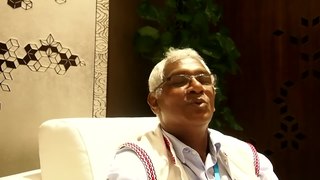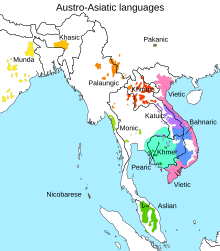
The Austroasiatic languages are a large language family spoken throughout mainland Southeast Asia, South Asia and East Asia. These languages are natively spoken by the majority of the population in Vietnam and Cambodia, and by minority populations scattered throughout parts of Thailand, Laos, India, Myanmar, Malaysia, Bangladesh, Nepal, and southern China. Approximately 117 million people speak an Austroasiatic language, of which more than two-thirds are Vietnamese speakers. Of the Austroasiatic languages, only Vietnamese, Khmer, and Mon have lengthy, established presences in the historical record. Only two are presently considered to be the national languages of sovereign states: Vietnamese in Vietnam, and Khmer in Cambodia. The Mon language is a recognized indigenous language in Myanmar and Thailand, while the Wa language is a 'recognized national language' in the de facto autonomous Wa State within Myanmar. Santali is one of the 22 scheduled languages of India. The remainder of the family's languages are spoken by minority groups and have no official status.

Santali, Bengali: সাঁওতালী, Odia: ସାନ୍ତାଳୀ, Devanagari: संताली, also known as Santal or Santhali, is the most widely-spoken language of the Munda subfamily of the Austroasiatic languages, related to Ho and Mundari, spoken mainly in the Indian states of Assam, Bihar, Jharkhand, Mizoram, Odisha, Tripura and West Bengal by Santals. It is a recognised regional language of India per the Eighth Schedule of the Indian Constitution. It is spoken by around 7.6 million people in India, Bangladesh, Bhutan and Nepal, making it the third most-spoken Austroasiatic language after Vietnamese and Khmer.

The fifteen Katuic languages form a branch of the Austroasiatic languages spoken by about 1.3 million people in Southeast Asia. People who speak Katuic languages are called the Katuic peoples. Paul Sidwell is the leading specialist on the Katuic languages. He notes that Austroasiatic/Mon–Khmer languages are lexically more similar to Katuic and Bahnaric the closer they are geographically. He says this geographic similarity is independent of which branch of the family each language belongs to. He also says Katuic and Bahnaric do not have any shared innovations, so they do not form a single branch of the Austroasiatic family, but form separate branches.

The Kharia language is a Munda language of the Austroasiatic language family, that is primarily spoken by the Kharia people of eastern India.

The Monic languages are a branch of the Austroasiatic language family descended from the Old Monic language of the kingdom of Dvaravati in what is now central Thailand. The Nyahkur people continue directly from that kingdom, whereas the Mon are descendants of those who migrated to Pegu after the 11th century Khmer conquest of Dvaravati.
The Khmuic languages are a branch of the Austroasiatic languages spoken mostly in northern Laos, as well as in neighboring northern Vietnam and southern Yunnan, China. Khmu is the only widely spoken language in the group.
The Pakanic languages constitute a branch of two Austroasiatic languages, Bolyu and Bugan. They are spoken in Guangxi and Yunnan provinces of southern China. Mang was formerly included, but is now considered by Paul Sidwell to form its own separate branch within Austroasiatic.

Sora is a south Munda language of the Austroasiatic language of the Sora people, an ethnic group of eastern India, mainly in the states of Odisha and Andhra Pradesh. Sora contains very little formal literature but has an abundance of folk tales and traditions. Most of the knowledge passed down from generation to generation is transmitted orally. Like many languages in eastern India, Sora is listed as 'vulnerable to extinction' by UNESCO. Sora speakers are concentrated in Odisha and Andhra Pradesh. The language is endangered as per as International Mother Language Institute (IMLI).

Korku is an Austroasiatic language spoken by the Korku tribe of central India, in the states of Madhya Pradesh and Maharashtra. It is isolated in the midst of the Gondi people, who are Dravidian, while its closest relatives are in eastern India. It is the westernmost Austroasiatic language.
Norman Herbert Zide was an American linguist and specialist in the Munda languages. Professor Emeritus at the University of Chicago. He taught Hindi and Urdu at the Department of South Asian Languages & Civilization at the Department of Linguistics for four decades and published several books and articles on the subject. However, his greater fame lies in his contributions to the Munda languages and to Austroasiatic linguistics in general. He has also done considerable work as a translator, especially of poetry. In The Oxford Anthology of Modern Indian Poetry, he did or assisted in translations of poetry from both North Indian and Austroasiatic languages. His undergraduate education was at Columbia University where he majored in French. In the 1950s he began to do graduate work in South Asian languages and linguistics.
The Juang language is a Munda language of the Austroasiatic language family spoken primarily by the Juang people of Odisha state, eastern India.

The Bonda language, also known as Bondo or Remo, is a south Munda language of the Austroasiatic language family spoken in Odisha, formerly known as Southern Odisha, in India. It had 2,568 speakers, all in Odisha, according to the 1951 Census of India, increasing to approximately 9,000 speakers in 2002 according to SIL.
The Gtaʼ language, also known as Gta Asa, Didei or Didayi, is an Austroasiatic language spoken by the Didayi people of southernmost Odisha in India.
Mundari (Munɖari) is a Munda language of the Austroasiatic language family spoken by the Munda tribes in eastern Indian states of Jharkhand, Odisha and West Bengal. It is closely related to Santali. Mundari Bani, a script specifically to write Mundari, was invented by Rohidas Singh Nag. It has also been written in the Devanagari, Odia, Bengali, and Latin writing systems.
The Khasi–Palaungic languages are a primary branch of the Austroasiatic language family of Southeast Asia in the classification of Sidwell. This is a departure from Diffloth (2005) classification of Khasi-Khmuic with Khmuic and Mangic (Pakanic) now being separate branches within Austroasiatic family.
Proto-Austroasiatic is the reconstructed ancestor of the Austroasiatic languages. Proto-Mon–Khmer has been reconstructed in Harry L. Shorto's Mon–Khmer Comparative Dictionary, while a new Proto-Austroasiatic reconstruction is currently being undertaken by Paul Sidwell.
Gorum, or Parengi, is a nearly-extinct minor Munda language of India.

The Munda peoples of eastern and central parts of the Indian subcontinent are any of several Munda speaking ethno-linguistic groups of Austro-asiatic language family, formerly also known as Kolarian, and spoken by about nine million people.
Kolarian is a word first used by George Campbell for Munda languages. He described it as one of the three non-Aryan language families of India, which he made up, along with the Tibeto-Burman and the Dravidian. It is a branch of Austro-asiatic languages spoken in the eastern regions of the subcontinent, and is also known as Munda languages. Its not a single tribal language but a group of tribal family languages. The speakers are called Kolarian tribes.
Proto-Munda is the reconstructed proto-language of the Munda languages of South Asia. It has been reconstructed by Sidwell & Rau (2015). According to Sidwell, the Proto-Munda language split from Proto- Austroasiatic in Indochina and arrived on the coast of Odisha around 4000 – 3500 years ago.








